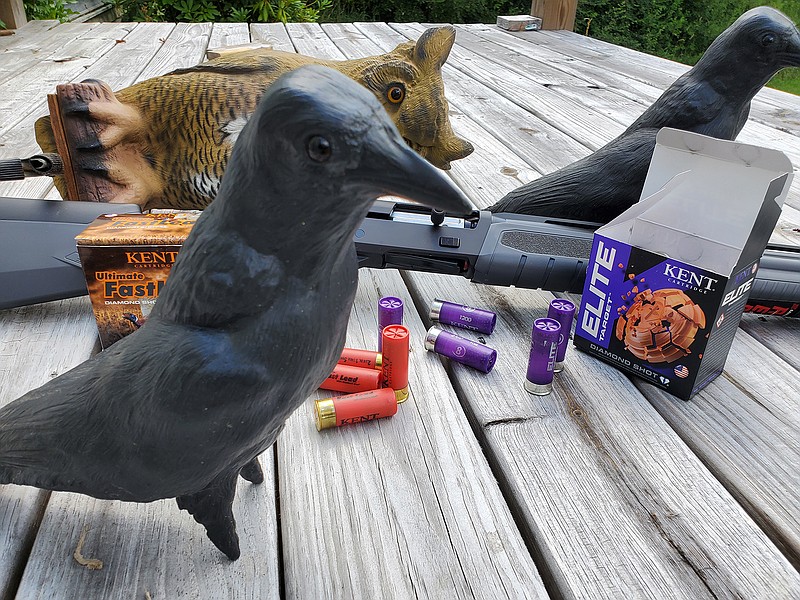AUTHOR'S NOTE: This is the second installment in a series on varmint hunting. Thanks for tuning in.
"No one mourns a crow." - Anonymous
The crow is one of those animals that doesn't seem to have many friends. Much like our little buddy the coyote, crows are considered varmints by most people, so they don't have a very big fan club. Crows are also considered pretty intelligent on the animal IQ board, though, and they are adaptable, hardy birds that seem to be able to survive about anywhere. Crows are gregarious, social birds that know how to make the most of staying in large groups.
They are also stone-cold killers.
Yep, it's true, and sorry to burst your bubble if you are one of the few crow lovers out there, but the crow is a predator and will get his dinner any way he can. Now don't get me wrong: I am not really judging Mr. Crow for this - there are lots of other predators out there in nature that do the same thing. Predators kill and eat prey animals to live; that is the way of things. I may not particularly like some of the choices that a crow makes when it comes to prey, but that is how it is. This ain't Disneyland.
Crows are a member of the genus Corvus, and there are at least 40 species of crows found on every continent except Antarctica and South America. The common American crow (Corvus brachyrhynchos) should in no way be mistaken for the larger member of the same family, the raven.
Ravens are totally different birds than crows, even though most folks will mistake one for the other. Ravens are much larger than crows, have a more prominent, thicker beak, and utilize a very different language and set of calls than the crow. Ravens are considered extremely intelligent and are, I think, very interesting. Ravens have a prominent place in a lot of mythology and Native American lore, so maybe I am not alone in a fascination with this somewhat oddball bird.
(Side note: Even though we will talk about hunting and shooting crows here, I am in no way whatsoever advocating shooting ravens. They are protected by law - both state and federal - and they do not fall into the varmint group that crows do. So we don't shoot ravens. Got that? Good, let's move on.)
The crow gets much of his bad reputation from the habitat of raiding garden crops, especially corn. Many is the hillside farmer who has uttered some not-so-nice words upon finding crows in his cornfield. Where do you think scarecrows came from? Crows aren't picky and will attack agricultural field corn as well as sweet corn for human consumption. The stage where they are the most destructive is when the corn sprout is just a few inches high. The crow will walk a row of corn and pull the young plants out of the ground by the roots. The corn seed that was planted is now soft and succulent because it sprouted. The crow snips the seed off the plant and eats it. A large flock of crows working this way on a field causes a lot of damage.
As mentioned before, crows are also opportunistic predators (and scavengers) and will take whatever they can get from the menu. Crows are past masters at robing the nest of several kinds of birds, both those that nest in trees and on the ground. They are expert egg thieves and probably account for the destruction of more wild turkey and grouse nests than we give them credit for. Songbirds also have much to fear from the crow tribe. If you have ever witnessed crows raiding a songbird nest and taking the young birds while the parents fly around helplessly, you know it is pretty hard to sit by and only say "Well, nature can be pretty cruel." You often see a songbird of some type chasing a crow and seemingly harassing it; now you know why.
Crows are hunted basically in two ways: with a shotgun or a rifle. On the shotgun end, crows are called in either with a mouth-blown call or an electronic device. This is usually done with the use of crow decoys and with a decoy of a great horned owl. Crows have a longstanding feud with owls as well as most hawks, and using a great horned owl decoy will often bring them in. Calling in a large group of crows can result in some fast shooting action, but it is not easy. Crows are wary and have extremely sharp eyesight, so crow hunters must be hidden well, and after the first barrage of shooting, the crows may leave the area and you will have to relocate and try again. I prefer a 12-gauge shotgun for this, but the 20-gauge will work as well. A modified choke is a good choice, with maybe No. 7 1/2 shot.
Several years ago, crows were listed as migratory birds by the United States Fish and Wildlife Service, so many states now have designated seasons when it is legal to take crows. Check the hunting regulations for your state and study the fine print before going afield for a crow hunt.
For the rifle shooter, crows can provide varmint hunting opportunities all year long (provided the legal season is in). Sharp-eyed rifle shooters have long looked to crows as challenging targets. A crow does not offer a very big target area, especially when you are shooting from several hundred yards away. This calls for a well-tuned varmint rifle and knowing how to allow for yardage and wind situations. The .17 HMR caliber, .22/250, .204 Ruger, and .223 Remington are all good choices for this, depending on yardage. An old favorite for this years ago was the venerable .220 Swift, which, sadly, you don't hear much about anymore. (There is a group looking to revive the .220 Swift that you can check out on the Facebook page "Long live the .220 Swift.")
Crows are part of the natural world, and they do what crows do. Putting them in the varmint class allows for some great offseason shooting opportunities. Check your state's regulations and go out and burn some powder on Mr. Crow. You may even save a turkey or songbird nest or two.
"The Trail Less Traveled" is written by Larry Case, who lives in Fayette County, W.Va. You can write to him at larryocase3@gmail.com.

